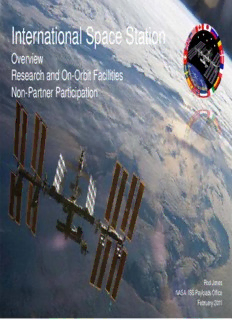
Recent Research Accomplishments on the International Space Station PDF
Preview Recent Research Accomplishments on the International Space Station
International Space Station Overview Research and On-Orbit Facilities Non-Partner Participation Rod Jones NASA ISS Payloads Office February 2011 International Space Station Created by a partnership of 5 space agencies representing 15 countries Over 10 years and 32 missions to assemble International Space Station Unique Features • Robust, continuous, sustainable microgravity platform • Continuous human presence in space • Access to the ultra high vacuum of space • 30kw steady state power for payloads • Unique altitude for observation and testing • Payload to orbit and return capability Why Microgravity Research? A candle flame in Earth's gravity (left) and microgravity (right) showing the difference in the processes of combustion in microgravity • Gravity is a constant force on Earth • It cannot be completely controlled or removed in experiments • It dominates and masks other forces in processes • The ISS provides a laboratory environment to control this force International Space Station Key Features • Supports both external and internal research • Automated, human, and robotic operated research • Exposure to the thermosphere • Nearly continuous data and communication link to anywhere in the world • Modularity and maintainability built into the design ensures mission life, allows life extension, vehicle evolution and technology upgrades International Space Station Facts Spacecraft Mass: +800,000 lb (+362,874 kg) Velocity: 17,500 mph (28,200 kph) Altitude: 220 miles above Earth Power: 80 kW continuous A collaboration of 5 space agencies 7 Research Resources on ISS NASA Research US National t n R e Space Operations Laboratory m u Exploration Systems Commercial Sector s g e Science Mission Non-profit organizations si a S Office of Chief Technologist U.S. Government Agencies n t i Russian S b r e O Research g - m n e O n . International t S . U Partner Research Biology and Biotechnology, Earth and Space Science, Educational Activities, Human Research, Physical & Material Sciences, Technology Demonstration On Orbit Payload Resources Power 30kw average ~37.5 Mbps of video (3 lines of video at 12.5 Mbps each) ~8 Mbps of MRDL data (Science return) Air to Ground Data ~5 Mbps for payload still imagery downlink ~20 Mbps utilized for payload data recorded over LOS 13 NASA Lab Internal Payload Racks 11 ESA Lab 10 JAXA Lab 8 NASA Truss ELC Platform Sites External Sites 10 JAXA Platform Sites 4 ESA Platform Sites Crew time 35 hrs per week (average) Human Operated Research 80000 AssemblyComplete 6-crew
Description: